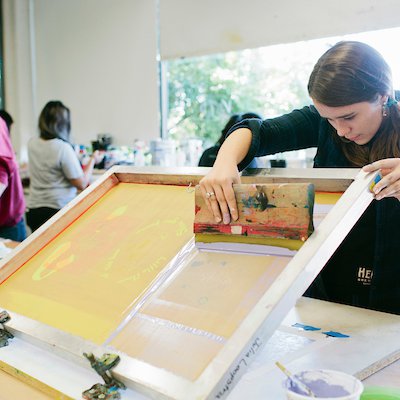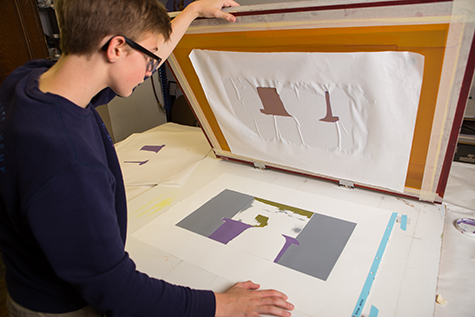Discover the Numerous Kinds of Screen Printing Techniques for Your Next Project
Screen printing uses a varied variety of strategies that can enhance any type of creative task. From standard techniques like serigraphy to modern-day developments such as direct-to-garment printing, each method has its distinct benefits. Specialty options, consisting of environmentally friendly and metallic inks, present a lot more possibilities. Recognizing these strategies can considerably affect the last outcome. The difficulty lies in picking the most ideal method for certain needs and preferred impacts. What factors should one consider?

The Basics of Screen Printing
Screen printing might seem complicated, it is fundamentally a straightforward process that includes transferring ink through a mesh screen onto numerous surfaces. The method begins with the creation of a stencil, which specifies the style to be published. This pattern is connected to a mesh screen, commonly made from polyester or nylon. Once the stencil is in area, ink is related to the screen and pressed with the mesh making use of a squeegee, resulting in the desired pattern being published on the underlying product.
Screen printing can be done on a wide variety of substrates, including material, paper, and plastic, making it a flexible selection for numerous jobs. The procedure enables dynamic shades and complex designs, making it popular in sectors such as art, style, and marketing. Understanding these fundamentals gears up people with the foundational expertise called for to explore advanced strategies in screen printing.
Conventional Screen Printing Techniques
Standard screen printing methods have been utilized for centuries, protecting the workmanship and creativity of this method. This method utilizes a mesh screen to move ink onto a substrate, such as textile or paper, permitting lively and long-lasting styles. The procedure begins with producing a pattern, which obstructs certain areas of the screen to manage where the ink will certainly be applied.
One preferred strategy is serigraphy, commonly utilized for artistic prints and minimal editions. An additional is making use of water-based inks, which are environmentally friendly and provide a soft feel on textiles - 10:9 Design LLC Company. In addition, traditional techniques can include hand-operated printing, where craftsmens apply ink with a squeegee, ensuring precision and attention to information
These techniques continue to be valued in the industry for their tactile high quality and the distinct structures they produce, appealing to both developers and customers that value the heritage of screen printing.
Digital Screen Printing Innovations
As the need for faster manufacturing and modification in the printing sector has actually risen, electronic screen printing developments have arised as a game-changer. This technology mixes standard screen printing methods with electronic processes, enabling quick prototyping and detailed layouts that were previously hard to accomplish. One substantial development is the intro of direct-to-garment (DTG) printing, which helps with high-quality, full-color prints on different textiles without the requirement for screens. Furthermore, developments in ink formulations have caused eco-friendly choices that preserve dynamic shades while minimizing ecological influence. The usage of automated systems additionally improves manufacturing, lowering labor costs and improving accuracy. These innovations not just accommodate small batch orders and tailored designs but additionally permit quicker turn-around times, making them ideal for services concentrated on meeting customer needs in a busy market. Digital screen printing, as a result, stands for an important evolution in the domain name of printing strategies.
Specialty Screen Printing Techniques
Discovering specialized screen printing techniques exposes a varied variety of techniques that press the limits of creative thinking and capability in the printing sector. Among these, glow-in-the-dark inks give a special aesthetic impact, making styles come alive in low-light problems. Metal inks, known for their glittering surface, include a touch of deluxe to printed products. Another ingenious approach is discharge printing, which gets rid of color from the textile as opposed to adding ink, resulting in a soft, classic feeling. High-density printing creates an increased appearance externally, enhancing responsive interaction. In addition, water-based inks are acquiring popularity for their dynamic colors and decreased ecological effect. Each of these specialty methods caters to particular layout needs, making it possible for brand names and artists to develop standout items that resonate with their target signs and posters near me markets. By leveraging these methods, services can raise their screen printing tasks to brand-new heights, guaranteeing unforgettable impressions.
Eco-Friendly Screen Printing Options
Eco-friendly screen printing alternatives are obtaining grip as the industry changes towards sustainability. Lasting ink options and making use of biodegradable products are key components in reducing the environmental influence of the printing process. By taking on these techniques, screen printers can add to an extra lasting future while preserving high-quality results.
Sustainable Ink Choices

Biodegradable Materials Usage
As the screen printing industry develops, the unification of eco-friendly products is ending up being progressively crucial for ecologically aware techniques. Makers and developers are currently checking out inks and substratums made from natural, renewable sources that break down much more effectively than traditional equivalents. These naturally degradable options reduce plastic waste and decrease environmental influence, lining up with the growing need for lasting products.
Typical instances include water-based inks and natural cotton materials, both of which minimize dangerous chemicals and advertise eco-friendliness. Brands that adopt these products often improve their market appeal, attracting consumers that prioritize sustainability. As recognition of environmental issues proceeds to increase, the shift in the direction of eco-friendly materials in screen printing is likely to obtain momentum, fostering a greener industry requirement.
Picking the Right Method for Your Job
How can one have a peek at this website determine one of the most appropriate screen printing method for a details task? The choice hinges on a number of aspects, including the product to be published on, the complexity of the layout, and the desired production quantity - 10:9 Design Abilene. As an example, direct-to-garment printing is ideal for elaborate designs with many shades, while typical screen printing excels for larger runs of simpler graphics
Additionally, consideration of the end-use of the published thing is necessary. For exterior applications, strategies that provide resilience and weather condition resistance, such as plastisol ink, might be chosen. Alternatively, environmentally-conscious jobs may take advantage of water-based inks or naturally degradable materials.
Ultimately, recognizing the project's unique demands permits for an informed option, making sure both visual appeal and functional durability. By reviewing layout complexity, product compatibility, and production scale, one can effectively pick one of the most ideal screen printing strategy to meet their job's goals.
Frequently Asked Inquiries
What Is the History of Screen Printing?
Screen printing originated in ancient China around 1000 ADVERTISEMENT, advancing through Japan and Europe. By the 20th century, it ended up being preferred in commercial art and fashion, transforming how designs were produced and distributed globally.

Exactly how Do I Prepare Artwork for Screen Printing?
To prepare art work for screen printing, one need to guarantee high resolution, make use of a suitable shade setting, produce different layers for each and every shade, and transform message to describes, ensuring compatibility with the printing procedure and preferred end result.
What Products Are Ideal for Screen Printing?
The very best products for screen printing include top quality inks, durable screens, and appropriate substrates like cotton, polyester, or blends. Furthermore, utilizing suitable emulsion and squeegees can improve the printing procedure and outcomes.
Can I Screen Print in the house?
Yes, screen printing in your home is feasible. With the best materials, configuration, and techniques, people can develop high-grade prints. Careful consideration of workspace and equipment is necessary for effective outcomes.
What Are Usual Mistakes in Screen Printing?
Common mistakes in screen printing consist of improper exposure times, poor ink uniformity, misalignment of screens, not enough cleansing of products, and neglecting to test prints. These mistakes can endanger the high quality and precision of the end product.
Screen printing may seem complicated, it is fundamentally a simple procedure that involves moving ink with a mesh screen onto numerous surface areas. As the need for faster manufacturing and personalization in the printing sector has surged, digital screen printing innovations see post have actually emerged as a game-changer. Discovering specialty screen printing methods exposes a diverse variety of techniques that press the limits of creativity and functionality in the printing sector. The best products for screen printing consist of premium inks, resilient displays, and ideal substratums like cotton, polyester, or blends (10:9 Design Screen Printing Texas). Typical blunders in screen printing consist of improper exposure times, inadequate ink consistency, misalignment of screens, not enough cleaning of materials, and disregarding to examine prints